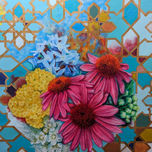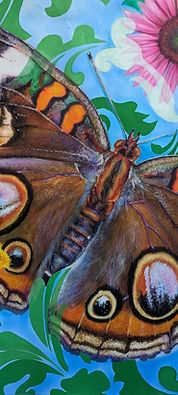Wild Medicine Eco Mural 20: Artelo
Location: Artelo Hotel, Room 7, 201 Birch St, Kennett Square, PA | Date: 2024
Artist: Designed, illustrated, and painted by Hagopian Arts
.jpg)
A Celebration of Interconnection
Our delicate ecosystems rely on the intricate relationships between plants, pollinators, and human communities. Wild Medicine Eco Mural 20: Artelo celebrates this mutual interconnectedness through a vibrant depiction of local flora, fauna, and their vital roles within the environment. Created by Hagopian Arts in collaboration with Square Roots Collective (SRC), this mural embodies the synergy between nature, culture, and community.
SRC, a 501(c)4 nonprofit, owns Artelo, an art-filled hotel designed to benefit the local community while engaging area artists. In addition, SRC oversees The Creamery, a beer garden and community space, and the Kennett Trails Alliance, a pedestrian and bicycle trail connecting Kennett Township and Borough. These projects, along with others, are advancing Birch Street in Kennett Square as a hub for art, culture, and community. One hundred percent of proceeds from The Creamery, Artelo, and SRC’s real estate ventures on Birch Street are reinvested into community nonprofits, further demonstrating SRC’s commitment to fostering interconnected and thriving communities.

Ecological and Cultural Connections
Further honoring the theme of interconnection, Wild Medicine Eco Mural 20 highlights edible and medicinal flora growing near Artelo and The Creamery. Plants depicted in the mural include Milkweed, Common Ninebark, Dwarf Alberta Spruce, Red Twig Dogwood, Yarrow, Joe Pye Weed, Blue Star, Echinacea, and Black-Eyed Susans, alongside native pollinators such as Monarch Butterflies and Eastern Tiger Swallowtail Butterflies.
The mural’s design, painted in Hagopian Arts’ signature style, integrates geometric patterns in gold and turquoise, complementing the botanical elements. Like all Eco Murals, the artwork is accompanied by a scannable QR code, linking viewers to a dedicated webpage. This page provides in-depth descriptions of the mural’s partners, plants, and pollinators, including their identifying markers, cultural significance, and medicinal uses.

Interconnectedness in Ecosystems
Pollinators play a vital role in sustaining ecosystems, enabling the reproduction of many plants that form the backbone of our food systems and natural landscapes. Monarch Butterflies, in particular, are an iconic symbol of interconnection. Their lifecycle depends entirely on Milkweed, where they lay their eggs, and whose leaves are the sole food source for their caterpillars. Milkweed’s naturally occurring toxins protect Monarch larvae from predators, while adult butterflies rely on the nectar of Milkweed and other flowers for sustenance during their migration.
The Monarch’s migration to Mexico, where they overwinter, serves as a nod to the vibrant Hispanic culture prevalent in Kennett Square. The Monarch’s journey mirrors the movement of people, culture, and traditions that enrich this community, making the butterfly a powerful symbol of resilience, connection, and cultural identity.
The other plants featured in the mural also hold ecological, cultural, and medicinal significance:
-
Milkweed: Used by Indigenous peoples to treat warts and dysentery.
-
Common Ninebark: Traditionally used to treat tuberculosis and enhance fertility.
-
Dwarf Alberta Spruce: Brewed into tea for nourishment, with its inner bark consumed during harsh winters to stave off starvation.
-
Red Twig Dogwood: A flowering plant with medicinal and functional uses.
-
Yarrow: Its leaves, edible raw or cooked, were a hop substitute in beer production.
-
Joe Pye Weed: Edible and historically valued for its medicinal properties.
-
Echinacea and Black-Eyed Susans: Used by Indigenous peoples for treating colds, flu, and bacterial infections.
-
Blue Star (Amsonia): An ornamental species with striking blue flowers, enhancing the visual appeal of natural spaces.
These plants and their pollinators remind us of the fragile balance that sustains ecosystems. Habitat loss, pollution, and climate change threaten to unravel these connections, with devastating consequences for biodiversity and human health. Wild Medicine Eco Mural 20 aims to inspire community engagement with plant life, raising awareness about the importance of conservation and environmental stewardship.

Programs and Collaborations
Wild Medicine Eco Mural 20 also celebrated interconnectivity through collaborative programs:
-
Hyacinth Montessori School, West Philadelphia: Hagopian Arts led a workshop for children aged 6–12, teaching them about local flora and pollinators while they painted sections of the mural. The activity incorporated yoga and mindfulness practices led by Breathe Moore, blending creativity with well-being.
-
John Heinz National Wildlife Refuge: Community members participated in painting sections of the mural while learning about the species featured.
-
Hispanic Heritage Festival, Kennett Square (September 2024): Hagopian Arts, SRC, and the Kennett Trails Alliance hosted a public mural painting event using a paint-by-number system. Participants painted sections inspired by the flora, fauna, and geometric designs of the mural.
The mural, finalized by Hagopian Arts, is slated for installation in Kennett Square in 2025.

Wild Medicine Eco Mural 20: Artelo is a testament to the power of collaboration, celebrating the intricate connections between plants, pollinators, and communities. By highlighting these relationships and addressing environmental challenges, the mural encourages us all to engage more deeply with nature, fostering resilience and flourishing ecosystems. Hagopian Arts looks forward to future partnerships with SRC and the Kennett Trails Alliance to continue advancing this vital work.
About the Eco Mural and Wild Medicine Projects
The Eco Mural Project by Hagopian Arts is an ongoing series of public art installations designed to educate and inspire action on ecological and cultural issues. Each mural is a meticulously detailed, one-of-a-kind piece, blending vibrant artistry with rigorous research. These murals transport viewers into immersive natural environments, revitalizing urban spaces while addressing pressing concerns about environmental degradation.
Within this initiative, the Wild Medicine Eco Mural Project focuses specifically on the cultural heritage of medicinal plants. Through detailed depictions and thoughtful programming, the series highlights the historical, cultural, and healing significance of plants, fostering a deeper connection between individuals and the natural world.
The Eco Mural Project is rooted in the belief that reconnecting communities with nature can profoundly impact mental and physical health. These murals showcase the beauty of local flora and fauna, enlivening public spaces and encouraging residents to see their environment in a new light. This engagement inspires a sense of pride, belonging, and collective responsibility for the natural world. To enhance accessibility, each mural includes a scannable QR code linking viewers to a webpage that provides detailed information about the artwork, the plants featured, and their historical and cultural significance. These pages also honor Indigenous histories by sharing the uses, markers, and cultural associations of the depicted flora and fauna.
Community-Driven Programming and Collaborations
Hagopian Arts amplifies the impact of its murals through live events, educational initiatives, and community partnerships that engage people across generations and cultures.

Honoring Indigenous Histories and Local Ecosystems
A standout project in the Wild Medicine Series is Eco Mural 21 at Bartram’s Garden, a series of freestanding mini murals showcasing medicinal plants historically used by the Lenni Lenape people. Designed with community input, the murals feature local flora, Lenape beadwork patterns, and depictions of children on the riverbank where passionflowers grow.
Hagopian Arts conducted extensive research into Bartram’s Garden’s historical catalog to honor the Lenape people’s contributions and highlight the cultural significance of the plants. At the unveiling event on September 15th, Melaney Gilchrist, a West Philadelphia herbalist, and mindfulness yoga practitioner Nakesha Moore of Breathe Moore led workshops for community families. These sessions explored the medicinal properties of the plants while fostering connections between art, history, and wellness practices.
Through its murals and programming, Hagopian Arts creates vibrant spaces for education, inspiration, and dialogue. The Eco Mural Project bridges art and environmental advocacy, encouraging communities to cherish their local ecosystems and honor the cultural and historical ties that bind them to the natural world.
Wild Medicine: A Multidimensional Creative Experience
This live event combined public art, botanical installations, body-painted models, and performance art to merge the worlds of creativity and herbal wisdom. Hosted in collaboration with women artists, herbalists, and grassroots organizers, the event invited participants to explore the healing connections between art and nature.
Ancient Ancestral Connections
Eco Mural 18: Women’s Wild Medicine celebrates the ancestral bond between women and medicinal plants, featuring women from diverse cultural backgrounds alongside flora from their heritage. Installed at Penn OB/GYN, the mural also serves as a pilot for the Women’s Wild Medicine Initiative, a community-driven effort that highlights the healing power of native plants and their historical ties to women.
Wild Medicine Coloring Journal and Foraging Guide
In collaboration with educator and illustrator Katie Lillard, Hagopian Arts produced the Wild Medicine Journal and Coloring Illustration Booklet, inspired by the two murals created for Wild Medicine Eco Mural 15: Mugwort, Mullein, and Mallow. The booklet features twenty medicinal plants rendered in Hagopian Arts’ signature style, blending pattern, naturalism, and realism.
Hagopian Arts distributed the journal and accompanying foraging guides to schools and community organizations to introduce youth aged 3-18 to ecological awareness in both traditional and nontraditional learning settings. These resources were also shared during a mural unveiling, empowering community members to safely connect with wild plants and explore their uses in daily life.
Highlighting Interconnectivity: Eco Mural 20
As part of the Wild Medicine Eco Mural Project, Hagopian Arts created Eco Mural 20: Artelo to celebrate the interdependent relationships between plants, pollinators, and human communities. This mural was a collaborative effort with Square Roots Collective and 14 other public artists contributing uniquely to the Artelo hotel project. While each artist brought a distinct vision to the hotel’s art-filled rooms, Hagopian Arts focused on the ecological and cultural themes central to the Wild Medicine Eco Mural Project.
To expand its reach, Hagopian Arts hosted interactive workshops that engaged community members in the creative process: At Hyacinth Montessori School in West Philadelphia, children aged 6–12 participated in a painting workshop, learning about local flora and pollinators while contributing sections to the mural. This activity incorporated yoga and mindfulness practices led by Breathe Moore, blending creativity and well-being.
At John Heinz National Wildlife Refuge, community members painted portions of the mural while learning about the featured species and their roles in local ecosystems.
In September 2024, Hagopian Arts partnered with the Kennett Trails Alliance and Artelo for a public mural painting event during the Hispanic Heritage Festival in Kennett Square. Using a paint-by-number system and hand-mixed colors, participants painted sections inspired by the flora, fauna, and geometric patterns of Eco Mural 20. The mural, once finalized by Hagopian Arts, will be installed in Kennett Square in 2025, further expanding its impact and reach.

Hagopian Arts transforms urban landscapes through art that bridges the worlds of ecology, education, and cultural heritage. Each mural is a portal into the hidden wonders of the natural world. By blending intricate artistry with educational outreach, Hagopian Arts inspires communities to rediscover the beauty and importance of the environment they call home.

A Guide to the Flora and Fauna of Wild Medicine Eco Mural 20: Artelo
Black-Eyed Susan
A perennial flower known for its bright yellow, daisy-like petals with dark brown centers, Black-Eyed Susan is commonly found in meadows, prairies, and roadsides across North America. Closely related to Echinacea, it has traditionally been used to treat colds and the flu. Indigenous peoples also utilized its antibacterial properties topically for treating snake bites, earaches, and minor cuts.
Threats: Habitat loss from agricultural expansion and urban development reduces the availability of meadows and prairies where Black-Eyed Susans grow. Its pollinators, such as bees and butterflies, are also threatened by pesticide use and climate change.
Blue Star
Native to North America, Blue Star grows in open woods, along stream banks, and in prairies. This perennial features narrow, lance-shaped leaves and clusters of pale blue, star-shaped flowers. While not commonly used for medicinal purposes, Blue Star serves as a host plant for several butterfly and moth species and supports early-season pollinators like bees and hummingbirds.
Threats: Deforestation, stream bank erosion, and agricultural runoff threaten its natural habitats. The pollinators it supports are also at risk from pesticide use and declining floral diversity.
Common Ninebark
A shrub with peeling bark, white or pinkish flower clusters, and lobed leaves, Common Ninebark thrives in wetlands, woodlands, and along streams in the eastern and central United States. Indigenous peoples used the inner bark in teas or washes to treat gonorrhea, tuberculosis, and pain. The tea was also employed to enhance fertility.
Threats: Wetlands and riparian zones where Ninebark thrives are endangered by land drainage, climate change, and invasive species. Its pollinators, including native bees, are impacted by habitat destruction and pesticide use.
Dwarf Alberta Spruce
An evergreen shrub native to North America, Dwarf Alberta Spruce has a conical shape and grows slowly to a height of up to eight feet, making it a popular choice for landscaping. Its needles are edible and were traditionally used to brew Vitamin C-rich tea. Indigenous peoples also consumed its inner bark during harsh winters and famines to stave off starvation. All parts of the tree are nontoxic.
Threats: Climate change affects its growth in native regions, while urbanization and logging contribute to habitat loss. It indirectly supports wildlife dependent on evergreen habitats, which are also under threat.
Echinacea
Part of the daisy family, Echinacea typically grows in prairies and wooded areas. Its pinkish-purple, yellow, red, or white petals surround a central grouping of tiny orange or yellow flowers. Renowned for its immune-boosting properties, Echinacea tea is used to reduce symptoms of coughs, colds, and sore throats. The plant’s stems possess anti-inflammatory and pain-relieving properties, while its roots, flowers, and juice have been used to treat infections and wounds.
Threats: Overharvesting for medicinal use and habitat destruction are major threats to wild Echinacea populations. Pollinators such as bees and butterflies that rely on its nectar face challenges from pesticide use and habitat fragmentation.
Joe Pye Weed
A tall plant with clusters of pinkish-purple flowers and a sweet, attractive scent, Joe Pye Weed is native to Eastern and Central North America. It thrives in various conditions, including wet and well-drained soil, full or partial sun, and hot or cold climates. Traditionally, Indigenous peoples used it to treat fevers, typhus, kidney stones, and urinary tract infections.
Threats: Wetland destruction and agricultural practices reduce its natural habitats. Pollinators such as butterflies and bees, which are crucial for its reproduction, are declining due to environmental stressors like pesticides and climate change.
Milkweed
A herbaceous flowering plant found in meadows, prairies, and roadsides throughout North America, Milkweed has broad, elongated leaves and clusters of pink, yellow, white, or purple flowers. Monarch caterpillars rely exclusively on Milkweed, particularly species with higher levels of cardenolide, a toxin that protects them from predators. Its milky, latex-rich sap has been used historically by Indigenous peoples to treat warts, while its roots were chewed to relieve dysentery. Salves and infusions made from Milkweed have been applied for respiratory ailments, swelling, rashes, and fevers.
Threats: Habitat loss, herbicide use, and climate change are reducing Milkweed populations, endangering Monarch Butterflies, which depend on it throughout their lifecycle.
Red Twig Dogwood
A shrub with dark red branches and broad oblong leaves, Red Twig Dogwood thrives in diverse conditions, including full sun, partial shade, and wet soils. Its leaves turn vibrant red or purple in the fall. Indigenous peoples consumed its bitter white berries both raw and cooked. The bark was used internally to treat pain, diarrhea, fevers, and digestive issues, while bark and root bark were applied externally for poison ivy, sore eyes, and ulcers.
Threats: Urban development, soil erosion, and changes in wetland hydrology threaten its habitats. The pollinators that rely on its flowers, such as bees, face risks from pesticide use and habitat fragmentation.
Yarrow
Native to grasslands in temperate regions across the globe, Yarrow is a flowering plant that grows up to 40 inches tall. It produces small white, yellow, or red flowers and fern-like foliage with a distinctly pungent odor. Its young leaves can be consumed raw or cooked and are often added to mixed salads for their bitter flavor. Historically, Yarrow has been used as a hop substitute for flavoring and preserving beer, and its leaves and flowers have been used in making liquors. Medicinally, Yarrow has astringent properties that aid in wound care, fever reduction, and treating digestive issues.
Threats: Grassland conversion to agriculture and urban areas threatens Yarrow’s habitats. The pollinators it supports, including bees and butterflies, are impacted by habitat loss and pesticide exposure.













































_edited.jpg)
.jpg)
.jpg)


